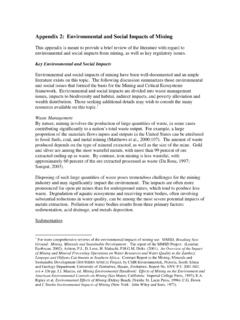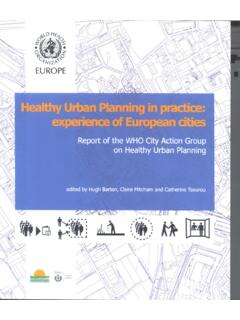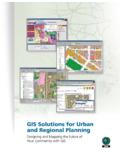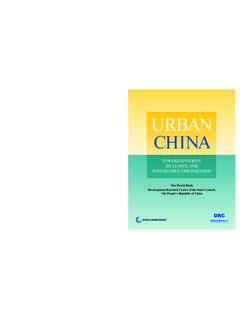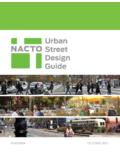Transcription of SuStainable urban tranSport in india
1 SuStainable urban tranSport in india Role of the Auto-rickshaw SectorAKSHAY MANI, MADHAV PAI, RISHI 2report by:AkshAy MAniproject Manager urban transporteMbarQ india PaidirectoreMbarQ india Aggarwalassociate institutional relationseMbarQ and layout by:nick 1 SuStainable urban tranSport in indiatable oF ContentS5 Executive summary11 introduction17 urban tranSport Trends and Challenges21 Understanding the Auto-rickshaw sector in Cities27 Role of the Auto-rickshaw sector in Promoting SuStainable urban Transport35 The Way Forward40 Citations41 2about Writhe World resources institute is a global environmental think tank that goes beyond research to put ideas into action. We work with governments, companies, and civil society to build practical solutions to urgent environ-mental challenges. Wri s transformative ideas protect the earth and promote development because sustainability is essential to meeting human needs and fulfilling human aspirations for the eMbarQthe eMbarQ global network catalyzes environmentally and financially SuStainable tranSport solutions to improve quality of life in 2002, the network has grown to include five Centers for SuStainable tranSport , located in Mexico, brazil, india , turkey and the andean region, that work together with local tranSport authorities to reduce pollution, improve public health, and create safe, accessible and attractive urban public spaces.
2 The network employs more than 100 experts in fields ranging from architecture to air quality management; geography to journalism; and sociology to civil and tranSport engineering. 3 SuStainable urban tranSport in india ForeWordSince the introduction of auto-rickshaws in india in the late 1950s, these vehicles have become an indispensable aspect of urban mobility for millions of rickshaws play a vital and vibrant role in india s urban tranSport systems. Yet they also represent a very improvisational and increasingly inefficient sector and they are getting lost in the changing dynamics of urban mobility in , with increasing urban populations, there is growth in demand for urban tranSport , growth in private motorization and a decline in public tranSport share. How do auto rickshaws fit in and have a role that is efficient for both the opera-tors and their passengers? And how can these three-wheeled wonders contribute to urban tranSport sustainability through both reductions in emissions and safety for everyone on the roads?
3 This report addresses how the auto rickshaw sector can play a key role in improv-ing sustainability for urban tranSport , and addresses negative perceptions of rickshaws. We also introduce new models of regulation and reforms that can be adopted for a more efficient and safer system and enable the rickshaw to have an optimal role in the tranSport is our hope that this study will make a useful contribution to the deliberations, planning and decision making of municipal, state and national officials to ensure the role of the auto-rickshaw sector in promoting SuStainable urban tranSport . And we hope that it will contribute to the safety of our fellow citizens and the environmental health of our PaiDirector EMBARQ 4 5 SuStainable urban tranSport in indiaexecutive Summary deMand For the auto-riCkShaWStudy Objective and Approach | as the demand for urban tranSport increases in india , so too does the popularity of the auto-rickshaw.
4 Production of this type of motorized three-wheeler has doubled between 2003 and 2010. in major indian cities, it is responsible for a significant share of motorized trips. Strategies to improve urban tranSport must include a policy vision for this increasingly important sector. to that end, this paper examines the role the auto-rickshaw sector can play in promoting SuStainable urban tranSport in india . it develops a policy vision for this sector and presents recommendations on reforms to address sustainability challenges. 6 The Avoid-Shift-Improve (ASI) framework, one of the key approaches to promote SuStainable urban tranSport , is the basis of this study. The ASI frame-work is based on three key strategies: (1) avoid unnecessary trips, (2) shift to more SuStainable tranSport modes, and (3) improve performance in all modes (Dalkmann and Brannigan 2007). In assessing the role of the auto-rickshaw sector in promoting SuStainable urban tranSport , this paper looks specifically at how auto-rickshaws can contribute to Shift and Improve strategies, using a two-pronged approach: Examination of the role of the type of service (contract carriage) provided by auto-rickshaws in promoting SuStainable urban tranSport , as part of the Shift strategy.
5 Assessment of the need for improvements in the type of vehicle (motorized three-wheeler) in the auto-rickshaw sector to promote SuStainable urban tranSport , as part of the Improve of Auto-rickshaw Sector in Promoting SuStainable urban Transportrole of the type of Ser vice (Contract Carriage) The findings from this study indicate that auto-rick-shaw services in cities can help meet the objectives of the Shift strategy of promoting public tranSport and reducing private motorization based on the following aspects: FiRsT AnD lAsT MilE ConnECTiviTy To PUbliC tranSport : Auto-rickshaw services, integrated as a feeder mode providing such connectivity, can complement public tranSport systems by ensuring that all parts of the city have easy ac-cess to public tranSport stations. DooR-To-DooR tranSport AlTERnATivE To PRivATE MoToR vEhiClEs: The door-to-door on-demand service provided by auto-rickshaws will ensure that tranSport needs requiring door-to-door connectivity, such as occasional trips to the airport or emergency trips for health care, can be met in cities without having to rely on private motor performance and need for improvements This paper assesses the performance of the mo-torized three-wheeler (auto-rickshaw) in Indian cities with respect to two important sustainability parameters emissions and road safety to identify current challenges and areas for vehicle-related reforms that can improve performance: EMissions: A key challenge in the auto-rickshaw sector is its emissions of particulate matter of aerodynamic diameter of less than 10 microns (PM10).
6 PM10 are known to have ad-verse impacts on health, and the conventional two-stroke engine auto-rickshaws prevalent in many cities are major sources of these emis-sions (Shah and Iyer 2004). RoAD sAFETy: The paper looks at the impact of the auto-rickshaw sector on the safety of both city pedestrians and the rickshaws occupants (driver and passengers). Research conducted by EMBARQ india using pedestrian fatality data for Mumbai and Bangalore shows that auto-rickshaws lead to fewer fatal pedestrian acci-dents than do motorized two-wheelers and cars. This is likely a result of their lower speeds and lighter weights (Mohan and Roy 2003). There are concerns for the safety of auto-rickshaw oc-cupants, however, particularly in multivehicle collisions (ones between auto-rickshaws and other motor vehicles). A study of auto-rickshaw injury patterns in Hyderabad revealed that multivehicle collisions were the leading cause of injury for auto-rickshaw occupants (Schmucker et al.)
7 2009).The Way Forward for the Auto-rickshaw Sector in Indian Citiespolicy Vision The National urban tranSport Policy (NUTP) of the Ministry of urban Development, Government of india , is the key guiding policy at the national level focusing on urban tranSport in india (MoUD 2006). With the underlying rationale of people-based tranSport planning, the NUTP framework focuses on planning and investments in public tranSport and nonmotorized tranSport (NMT) systems in cities. 7 SuStainable urban tranSport in india To meet the objectives of the NUTP, the findings from this study highlight the need for an overarch-ing policy vision for the auto-rickshaw sector in urban tranSport (Figure ) based on the Shift and Improve strategies of the ASI framework to pro-mote SuStainable urban needs and next StepsIn accordance with the policy vision, the following regulatory and vehicle-related reforms will help ensure that the auto-rickshaw sector supports pub-lic tranSport and provides alternatives to private vehicles, while addressing the sustainability chal-lenges of emissions and road safety: EnsURE AvAilAbiliTy oF DisPATCh sERviCEs: Auto-rickshaw services in the majority of Indian cities are provided by individual owner-operators rather than by fleet companies.
8 The lack of organization makes it difficult to provide dispatch (dial-a-rickshaw) services. This needs to be addressed through regulatory reforms that enable fleet-based operations with dispatch services to enter the auto-rickshaw sector. These regulatory reforms should be pursued by State tranSport departments, which are the nodal regulatory agencies for the auto-rickshaw sector. REDUCE EMissions: Findings from this study highlight that improvements in engine technol-ogy (moving from two-stroke to four-stroke en-gines) is potentially the best approach to reduce PM10 emissions from the auto-rickshaw sector. Four-stroke engines have lower PM10, hydrocar-bon (HC), and carbon dioxide (CO2) emissions than two-stroke engines (Shah and Iyer 2004). Further, four-stroke engines can reduce PM10 emissions by running on compressed natural gas (CNG) and other alternatives to gasoline (Reyn-olds, Grieshop and Kandlikar, 2011).
9 However, higher oxides of nitrogen (NOx) emissions from four-stroke engines need to be addressed through reforms in current emission standards. The engine and fuel-related reforms should be pursued by State tranSport departments as the nodal regulatory agencies. The needed reforms in emission standards are the adoption of separate emission stan-dards for HC and NOx emissions, instead of the current combined (HC + NOx) standard. These reforms should be pursued by the Standing Committee on Implementation of Emissions Legislation set up by the Ministry of Road tranSport and Highways (MoRTH) for emissions legislation (SIAM 2011b). iMPRovE RoAD sAFETy: Vehicle design improve-ments such as seat belts and padding on stiff surfaces (Schmucker et al. 2009) have been noted as key reform needs to improve occupant safety in multivehicle collisions. Further, infra-structure interventions such as dedicated lanes for auto-rickshaws, narrow lanes, and speed tables on urban roads to reduce average speeds will reduce the risk of occurrence of multive-hicle collisions.
10 Vehicle design improvements, through reforms in current motor vehicle safety regulations, should be pursued by the Automotive Industry Standards Committee (AISC) (SIAM 2011b) set up by MoRTH for motor vehicle safety regulations. Infrastructure interventions to improve auto-rickshaw occupant safety should be pursued by City governments as part of their citywide road safety enhancement services in cities can help promote public tranSport usage and reduce private 8 Figure | Policy vision for the Auto-rickshaw sector in Cities 11 SuStainable urban tranSport in india introduCtionObjective | india is experiencing rapid urbanization. according to a recent study, the population of indian cities will grow from an estimated 340 million in 2008 to 590 million by 2030 (Mckinsey & Company 2010). in the face of this expected growth, it is critical to improve urban tranSport to ensure high quality of life in indian cities, in terms of fast and reliable commutes, better air quality and public health, safe tranSport , and equitable mobility options for all sections of 12 The objective of this paper is to examine the role of the auto-rickshaw sector (motorized three-wheel-ers) in promoting SuStainable urban tranSport in india , to develop a policy vision for this sector, and to recommend reforms to address auto-rickshaws sustainability are a form of intermediate public tranSport (IPT).
